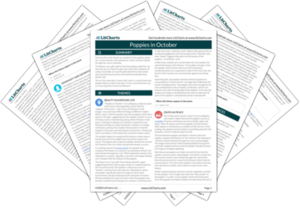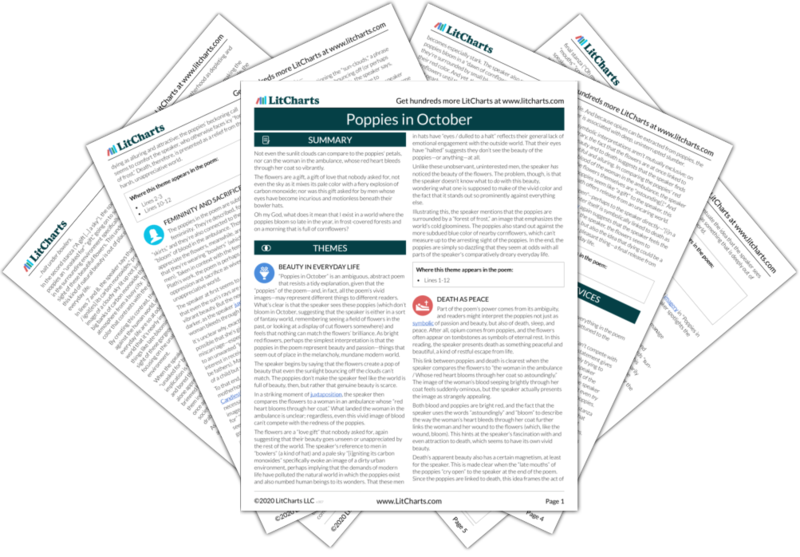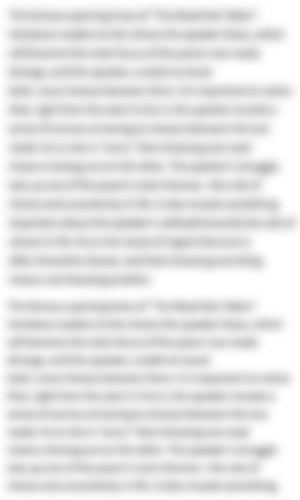
Sylvia Plath's "Poppies in October" is a melancholy poem that focuses on beauty in the natural world. The speaker notices vibrant red poppies in October, when the flowers don't typically bloom. Instead of simply welcoming this lovely sight, however, the speaker juxtaposes the flowers against the ugliness of the surrounding world, comparing them with images of pollution, blood, and human indifference. The poem is ambiguous and its symbolism open to interpretation, but one thing that seems clear is that the speaker sees the poppies not as a sign of happiness, but rather as a reminder that the rest of the world is bleak and sad in comparison. "Poppies in October" was included in Plath's second collection of poetry, Ariel. The collection was published posthumously in 1965, two years after the poet took her own life.
|
Get
LitCharts
|

|
The Full Text of “Poppies in October”
The Full Text of “Poppies in October”
-
“Poppies in October” Summary
-
-
“Poppies in October” Themes
-

Beauty in Everyday Life
Where this theme appears in the poem:- Lines 1-12
-

Death as Peace
Where this theme appears in the poem:- Lines 2-3
- Lines 10-12
-

Femininity and Sacrifice
Where this theme appears in the poem:- Lines 1-9
-
-
Line-by-Line Explanation & Analysis of “Poppies in October”
-
Lines 1-3
Even the sun-clouds ...
... so astoundingly — -
Lines 4-9
A gift, a ...
... halt under bowlers. -
Lines 10-12
Oh my God, ...
... dawn of cornflowers.
-
-
“Poppies in October” Symbols
-

Poppies
Where this symbol appears in the poem:- Lines 1-12
-
-
“Poppies in October” Poetic Devices & Figurative Language
-
Personification
Where personification appears in the poem:- Line 1: “Even the sun-clouds this morning cannot manage such skirts.”
- Lines 5-6: “Utterly unasked for / By a sky”
- Lines 10-12: “what am I / That these late mouths should cry open / In a forest of frosts, in a dawn of cornflowers.”
-
Juxtaposition
Where juxtaposition appears in the poem:- Line 1
- Lines 2-3
- Lines 6-9
- Line 12
-
Consonance
Where consonance appears in the poem:- Line 1: “Even,” “sun-clouds this,” “morning cannot manage,” “such skirts”
- Line 2: “woman,” “ambulance”
- Line 3: “blooms,” “so astoundingly”
- Line 5: “unasked”
- Line 6: “sky”
- Line 7: “Palely,” “flamily”
- Line 8: “Igniting its,” “carbon monoxides,” “by”
- Line 9: “Dulled,” “halt,” “under bowlers”
- Line 12: “forest,” “frosts,” “in,” “dawn,” “cornflowers”
-
Sibilance
Where sibilance appears in the poem:- Line 1: “sun-clouds this,” “such skirts”
- Line 3: “so astoundingly”
- Line 5: “unasked”
- Line 6: “sky”
- Line 12: “forest,” “frosts,” “cornflowers”
-
Assonance
Where assonance appears in the poem:- Line 1: “cannot manage”
- Line 2: “ambulance”
- Line 3: “Whose,” “blooms through,” “coat so”
- Line 4: “love”
- Line 5: “Utterly unasked”
- Line 6: “By,” “sky”
- Line 7: “Palely,” “flamily”
- Line 8: “Igniting its,” “monoxides, by eyes”
- Line 9: “under bowlers”
- Line 10: “my,” “I”
- Line 11: “cry”
-
Alliteration
Where alliteration appears in the poem:- Line 1: “sun,” “morning,” “manage,” “such skirts”
- Line 3: “Whose,” “heart”
- Line 5: “Utterly unasked”
- Line 8: “Igniting its”
- Line 11: “That these”
- Line 12: “forest,” “frosts”
-
Rhetorical Question
Where rhetorical question appears in the poem:- Lines 10-12: “Oh my God, what am I / That these late mouths should cry open / In a forest of frosts, in a dawn of cornflowers.”
-
Allusion
Where allusion appears in the poem:- Lines 1-12
-
Imagery
Where imagery appears in the poem:- Lines 1-3
- Lines 6-8
- Lines 10-12
-
-
“Poppies in October” Vocabulary
Select any word below to get its definition in the context of the poem. The words are listed in the order in which they appear in the poem.
- Sun-clouds
- Manage
- Skirts
- Utterly
- Palely
- Flamily
- Carbon monoxides
- Igniting
- Bowlers
- Halt
- Late mouths
-
(Location in poem: Line 1: “Even the sun-clouds”)
-
Form, Meter, & Rhyme Scheme of “Poppies in October”
-
Form
-
Meter
-
Rhyme Scheme
-
-
“Poppies in October” Speaker
-
-
“Poppies in October” Setting
-
-
Literary and Historical Context of “Poppies in October”
-
-
More “Poppies in October” Resources
-
External Resources
-
Sylvia Plath Reads the Poem Out Loud — Listen to Sylvia Plath read "Poppies in October."
-
The Poet's Life — To learn more about Sylvia Plath, check out this brief overview of her life and work.
-
Confessionalism — This article takes a look at Confessionalism, a branch of poetry often associated with Sylvia Plath's work (though some people think the term is reductive when it comes to Plath's poetry).
-
The Sylvia Plath Movie — Check out this trailer for "Sylvia," the 2003 film starring Gwyneth Paltrow as Plath and Daniel Craig as her lover Ted Hughes.
-
An Interview With Sylvia Plath — This recording documents an interview with Sylvia Plath that took place in 1962, around the time she most likely wrote "Poppies in October."
-
-
LitCharts on Other Poems by Sylvia Plath
-















